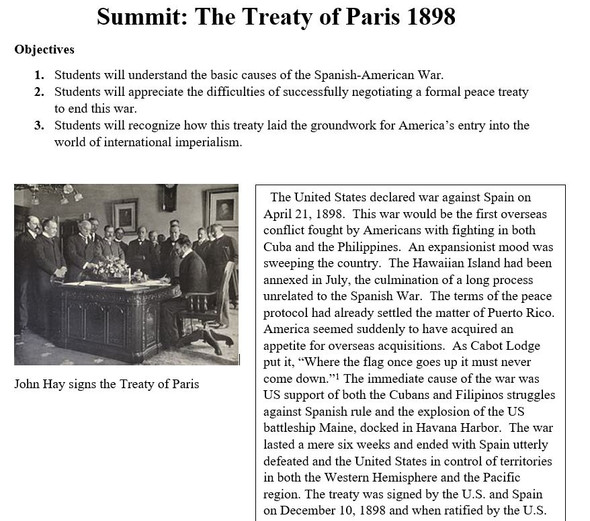Description
This is the third lesson of four about American wars and the treaties that settled those conflicts. We tend to think of peace negotiations as taking place after the end of a war, but in most cases peace discussions begin soon after the fighting starts. Peace treaties can be seen as summit meetings in which the causes which motivated the warring nations are set aside, and it is the obligation of each government’s negotiators to seek from that adjustment the most favorable conditions possible for its people, given the circumstances. The actual signing of the peace is the final striking of a bargain. The treaty that emerges is in many respects more significant than the war itself. Although the length, number of casualties, brutality and destruction can have a significant impact on actual terms of the treaty. As we have bitterly found out with our involvement in Iraq it is possible to win the war and lose the peace. Arguably a lesson we should have learned from the settlement that emerged at Versailles in 1919 that pretty much guaranteed a second world war.
This series begins with a treaty in 1814 between the United States and Great Britain, the nation who possessed the greatest Empire of the 19th century and ends in 1898 with a treaty between the United States and Spain, the nation who held the greatest Empire of the 16th and 17th centuries. In the former the United States finally achieved independence from England and created an Anglo-American bond that exists to this day. In the latter, the United States acquired an overseas empire and lifted itself into the realm of a world power. In between the United States negotiated treaties with Mexico and various native peoples, including the Sioux, Cheyenne, Comanche, Navaho and Arapaho that transferred most of the West into American hands.
Finally, these treaties raise many interesting and relevant questions in American history. Was it appropriate for the United States to use its moral imperative and military might to achieve what has been termed its “manifest destiny”? Is it possible to win the war and lose the peace? Were the treaties that emerged from the peace summits in America’s best interests? What role did politics, religion and personal ambition play in the shaping of these treaties? Would the treaties have been dramatically different if the U.S. had been less successful in the fighting? Has the U.S. honored its commitments in these treaties? If not, why not? How has America’s image in the world and its relations with other nations been shaped by these summits?
Students will grapple with these and other questions as they recreated the dramatic negotiations that framed these treaties and compare their negotiated settlements with those achieved by the actual American and foreign diplomats who framed the original treaties.











